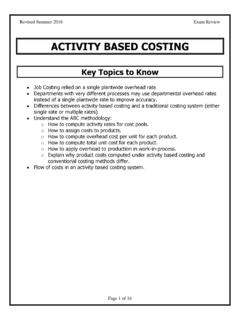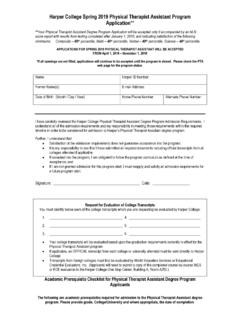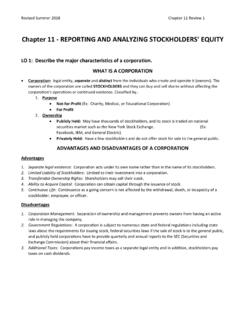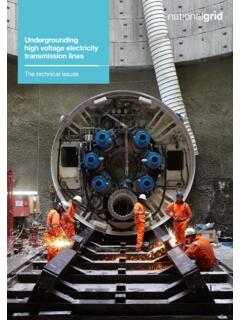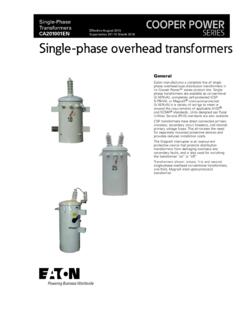Transcription of STANDARD COSTS AND VARIANCE ANALYSIS - Harper College
1 Revised Summer 2015 Page 1 of 20 STANDARD COSTS AND VARIANCE ANALYSIS Key Terms and Concepts to Know Static or Planning Budgets Used for planning purposes Prepared at the beginning of the period Based on one projected level of activity Standards: Standards are benchmarks or norms for measuring performance. Standards relate to the quantity and COSTS of inputs used in manufacturing goods or providing services. Price Standards specify how much should be paid for each unit of the input. Quantity Standards specify how much of an input such as raw material should be used to make a product or provide service.
2 STANDARD Costing: STANDARD costing allows companies to compare the actual results to expected or STANDARD results and to analyze the differences or variances between them. If there is a significant VARIANCE between the STANDARD and actual results, managers may investigate the discrepancy to find the underlying cause of the VARIANCE . STANDARD COSTS are used to value raw materials inventory, work-in-process inventory, finished goods inventory and cost of goods sold. All Variances: Variances are computed for each manufacturing cost : direct materials, direct labor, variable overhead and fixed overhead . The total VARIANCE for each manufacturing cost is the difference between the actual COSTS incurred and the flexible budget COSTS (the STANDARD COSTS that should have been incurred for the actual level of production).
3 O Actual cost incurred is actual price x the actual quantity for the good unit produced. o Flexible budget amount is STANDARD price x STANDARD quantity allowed. Revised Summer 2015 Page 2 of 20 o STANDARD quantity allowed is good units produced x STANDARD quantity per unit. The total VARIANCE is divided into price and quantity variances for each manufacturing cost . All variances are favorable or unfavorable. o Favorable if actual price or quantity is less than STANDARD price or quantity. o Unfavorable if actual price or quantity is greater than STANDARD price or quantity. The general VARIANCE model is: Actual Quantity X Actual Price Actual Quantity X STANDARD Price STANDARD Quantity X STANDARD Price Price Variances Quantity Variances SP (AQ - SQ) AQ (AP SP) DM Price DM Quantity DL Rate DL Efficiency or Time VOH Spending VOH Efficiency FOH Budget or Spending FOH Volume overhead variances may also be grouped into Controllable and Volume Variances.
4 Controllable variances, those that can be affected by management s decision regarding spending levels, are: Controllable VARIANCE = Variable overhead spending VARIANCE + Variable overhead efficiency VARIANCE + Fixed overhead budget VARIANCE The fixed overhead budget or spending VARIANCE is the difference between actual fixed overhead COSTS incurred and the budgeted fixed overhead COSTS . This difference is due to spending controllable by management and not to a difference in plant activity. For example, this VARIANCE could be caused by giving a factory supervisor a salary increase greater than budgeted, but not by the factory working more hours than budgeted.
5 The non-controllable VARIANCE is the Fixed overhead Volume VARIANCE . It measures the difference in plant capacity utilization between the STANDARD hours used for actual good units produced and the STANDARD hours at normal capacity. STANDARD hours at normal capacity is also the denominator activity used to calculate the predetermined or STANDARD variable and fixed overhead rates. Revised Summer 2015 Page 3 of 20 Key Topics to Know Direct Materials Variances Material Price VARIANCE o The difference between the actual unit price paid and the STANDARD price per unit of direct materials, multiplied by the quantity purchased.
6 O May result from many factors such as receiving more cash or quantity discounts than expected, price reductions or increases from the supplier or purchasing a different quality of materials. o Identified at time of purchase; formula is AQ (AP - SP) Material Quantity VARIANCE o The difference between the actual quantity of materials used in production and the STANDARD quantity allowed for the actual output, multiplied by the STANDARD price per unit of materials. o May result from many factors such as shortchanging the actual amount of material used, fewer rejects or spoilage than expected, faulty machines, inferior materials quality, untrained workers, and poor supervision.
7 O Identified at time of usage; formula is SP (AQ - SQ) Example #1 Harmon Household, Inc. manufactures a number of consumer items for general household use. During the recent month, the company manufactured 4,000 chopping blocks using 11,000 feet of hardwood. The hardwood cost the company $18,700 when purchased. According to the STANDARD cost card, each chopping block requires board feet of hardwood, at a cost of $ per board feet. Required: Compute the material quantity VARIANCE and material price VARIANCE . Revised Summer 2015 Page 4 of 20 Solution #1 AQ 11,000 X AP $ AQ 11,000 X SP $ SQ 4,000 x X SP $ = $18,700 = $19,800 = $18,000 $1,100 F $1,800 U Price VARIANCE Quantity VARIANCE AQ (AP SP) SP (AQ - SQ) 11,000($ $1,80) $ (11,000 10,000) Direct Labor Variances Labor Rate VARIANCE o The difference between the actual hourly labor rate and the STANDARD rate per hour, multiplied by the actual number of hours worked during the period.
8 O May result from many factors such as using workers with different wage rates than expected, different benefits COSTS per hour, annual wage rate increases more or less than expected, or a different number of overtime hours than expected. o Identified when direct labor hours are worked; formula is AH (AR - SR) Labor Efficiency or Time VARIANCE o The difference between the actual hours worked and the STANDARD hours allowed for the actual output, multiplied by the STANDARD hourly labor rate. o May result from many factors such as poorly trained or motivated workers, materials of a different quality than STANDARD , faulty equipment causing breakdowns and work interruptions, fewer equipment breakdowns than expected, poor supervision of workers, or using workers with different level of skills than expected.
9 O Identified when direct labor hours are worked; formula is SR (AH - SH). Revised Summer 2015 Page 5 of 20 Example #2 China Inc. produces custom-painted cake plates for a number of major department stores. During the most recent week, the company prepared 6,000 plates using 1,150 direct labor-hours. The company paid its direct labor workers at an average pay rate of $ per hour. According to the STANDARD cost card, each plate should require .20 direct-hours at a cost of $ per hour. Required: Compute the labor efficiency VARIANCE and a labor rate VARIANCE . Solution #2 AH 1,150 X AR $ AH 1,150 X SR $ SH 6,000 x.
10 20 X SR $ = $11,500 = $10,925 = $11,400 $575 U $475 F Rate VARIANCE Efficiency or Time VARIANCE AH (AR SR) SR (AH - SH) 1,150($ $ ) $ (1,150-1,200) overhead Variances overhead variances have a somewhat different meaning than direct materials and direct labor variances for two reasons: o overhead is an indirect cost whereas materials and labor are direct COSTS o overhead includes both variable and fixed COSTS overhead variances may be separated into Variable overhead Controllable and Fixed overhead Volume Variances. For overhead VARIANCE ANALYSIS , the STANDARD or pre-determined overhead rate based on total overhead COSTS is divided into variable and fixed rates, which are calculated by dividing budgeted variable or budgeted fixed overhead by the budgeted allocation base (now referred to as the denominator activity).

